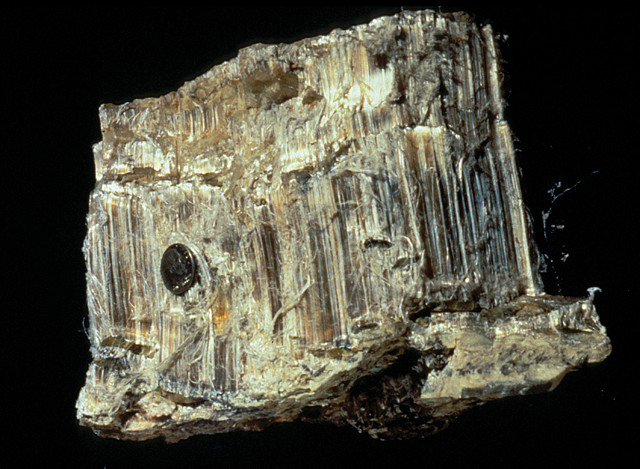
by U.S. Geological Survey Thursday, June 14, 2018
Robert Virta, mineral commodity specialist for the U.S. Geological Survey, prepared the following information on asbestos, a mineral commodity used for centuries but now in significant decline.

Chrysotile has long been the most commonly used form of asbestos. Credit: ©U.S. Geological Survey/ESW Image Bank
Asbestos is a generic name given to six needle-shaped minerals that have been used in commercial products. It is an industrial term rather than a mineralogical term, referring to specific fibrous mineral particles that possess high tensile strengths, large length-to-width ratios, flexibility and resistance to chemical and thermal degradation. Asbestos also exhibits high electrical resistance, and many forms can easily be woven into textiles. Even though asbestos markets have declined dramatically over the past 30 years because of health and liability issues, it is still used throughout the world.
The six minerals that have been used commercially as asbestos are actinolite, amosite (cummingtonite-grunerite), anthophyllite, chrysotile, crocidolite (riebeckite), and tremolite. Chrysotile is a serpentine group mineral and the other five are amphibole group minerals. Chrysotile has been the most commonly used form of asbestos, followed by crocidolite, amosite and anthophyllite. Relatively small amounts of tremolite and actinolite have been mined and used as asbestos.
Asbestos has been used to strengthen such products as concrete pipe and sheet, plastic components and gypsum plasters. Its most common use worldwide is in asbestos-cement pipe and sheet. It is also used in brake pads and shoes, steam pipe insulation and fire-resistant board, and its chemical stability allows it to be used where exposure to seawater and corrosive chemicals occurs.
Global asbestos consumption has declined significantly since the 1970s, when product manufacturers began using asbestos substitutes, such as aramid fiber, cellulose fiber, polyvinyl alcohol fibers or wollastonite, and alternative products, such as aluminum siding, ductile iron and polyvinyl chloride pipe, fiberglass shingles, metallic disk brake pads and mineral wool insulation. Due to these substitutions, U.S. consumption declined a thousand-fold from its peak in 1973, and world consumption was reduced by half during this same period. World asbestos consumption is likely to continue its slow decline as more countries institute bans on its use. Asbestos bans are in place in about 50 countries.
For more information on asbestos and other mineral resources, [visit minerals.usgs.gov/minerals](http://visit minerals.usgs.gov/minerals).
In 2008, world production of asbestos was estimated to be 2.1 million metric tons.
China, Russia, Canada, Kazakhstan and Zimbabwe are the leading producers of asbestos, accounting for 96 percent of world production. Asbestos has not been mined in the United States since 2002.
In the 1970s, the former Soviet Union and the United States accounted for about 42 percent of world consumption..
In 2008, the leading consuming nations of asbestos were China, India and Russia, followed by Brazil, Indonesia, Kazakhstan, Thailand and Ukraine. These eight countries accounted for an estimated 84 percent of world asbestos consumption in 2008.
The name “asbestos” derives from a Greek word for “inextinguishable” or “unquenchable” because it wasn’t consumed by flames when used as lamp wicks.
Asbestos was first used 4,500 years ago to strengthen clay pots; the first historical mention of asbestos is attributed to Theophrastus in his book “On Stones,” written in about 300 B.C.
In the 1940s and 1950s, asbestos was hailed for its “service to humanity.” It also was labeled a “boon to humanity,” “faithful servant of mankind,” and the “miracle mineral” because of its myriad uses at the time.
Asbestos was once used to make ironing board covers and to filter wines. It was also used on movie sets as snow and dust.
An individual asbestos fibril is 25 to 2,500 times smaller in diameter than the thickness of a human hair, depending on the asbestos type.
© 2008-2021. All rights reserved. Any copying, redistribution or retransmission of any of the contents of this service without the expressed written permission of the American Geosciences Institute is expressly prohibited. Click here for all copyright requests.